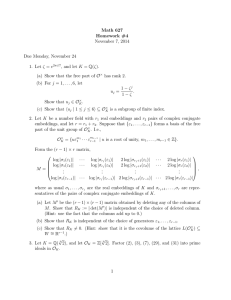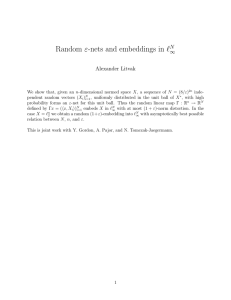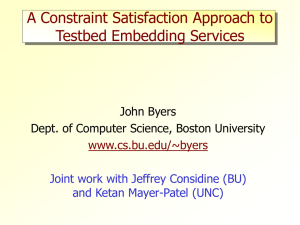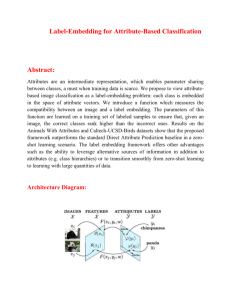OUT-OF-SAMPLE EXTRAPOLATION USING SEMI-SUPERVISED MANIFOLD LEARNING
advertisement
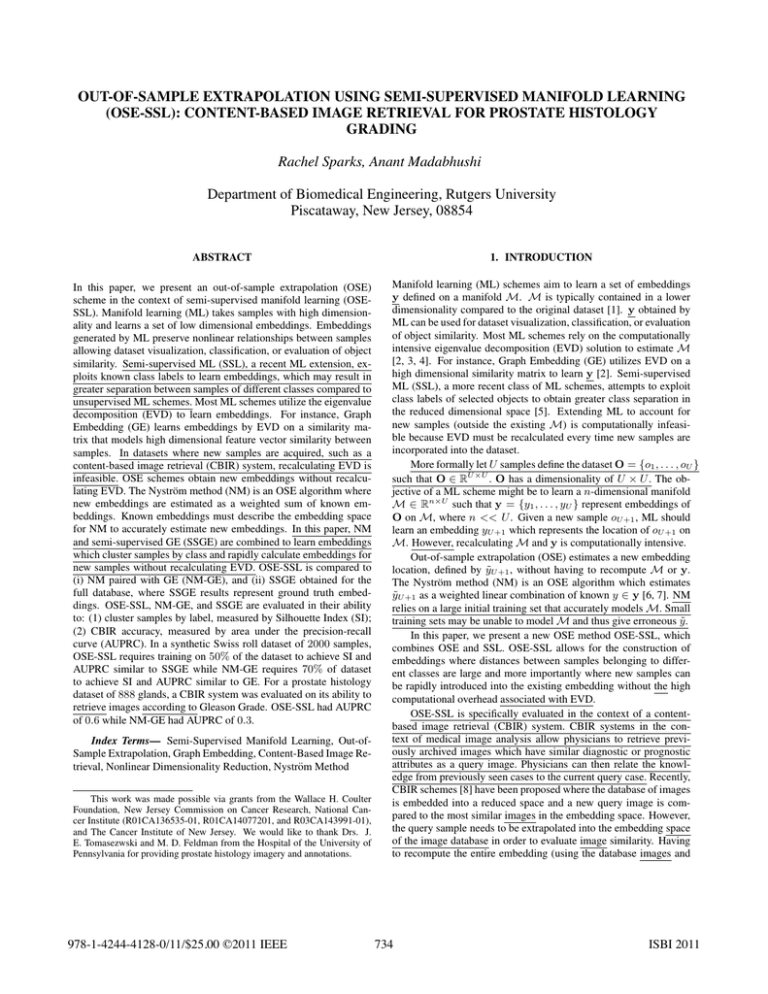
OUT-OF-SAMPLE EXTRAPOLATION USING SEMI-SUPERVISED MANIFOLD LEARNING
(OSE-SSL): CONTENT-BASED IMAGE RETRIEVAL FOR PROSTATE HISTOLOGY
GRADING
Rachel Sparks, Anant Madabhushi
Department of Biomedical Engineering, Rutgers University
Piscataway, New Jersey, 08854
ABSTRACT
In this paper, we present an out-of-sample extrapolation (OSE)
scheme in the context of semi-supervised manifold learning (OSESSL). Manifold learning (ML) takes samples with high dimensionality and learns a set of low dimensional embeddings. Embeddings
generated by ML preserve nonlinear relationships between samples
allowing dataset visualization, classification, or evaluation of object
similarity. Semi-supervised ML (SSL), a recent ML extension, exploits known class labels to learn embeddings, which may result in
greater separation between samples of different classes compared to
unsupervised ML schemes. Most ML schemes utilize the eigenvalue
decomposition (EVD) to learn embeddings. For instance, Graph
Embedding (GE) learns embeddings by EVD on a similarity matrix that models high dimensional feature vector similarity between
samples. In datasets where new samples are acquired, such as a
content-based image retrieval (CBIR) system, recalculating EVD is
infeasible. OSE schemes obtain new embeddings without recalculating EVD. The Nyström method (NM) is an OSE algorithm where
new embeddings are estimated as a weighted sum of known embeddings. Known embeddings must describe the embedding space
for NM to accurately estimate new embeddings. In this paper, NM
and semi-supervised GE (SSGE) are combined to learn embeddings
which cluster samples by class and rapidly calculate embeddings for
new samples without recalculating EVD. OSE-SSL is compared to
(i) NM paired with GE (NM-GE), and (ii) SSGE obtained for the
full database, where SSGE results represent ground truth embeddings. OSE-SSL, NM-GE, and SSGE are evaluated in their ability
to: (1) cluster samples by label, measured by Silhouette Index (SI);
(2) CBIR accuracy, measured by area under the precision-recall
curve (AUPRC). In a synthetic Swiss roll dataset of 2000 samples,
OSE-SSL requires training on 50% of the dataset to achieve SI and
AUPRC similar to SSGE while NM-GE requires 70% of dataset
to achieve SI and AUPRC similar to GE. For a prostate histology
dataset of 888 glands, a CBIR system was evaluated on its ability to
retrieve images according to Gleason Grade. OSE-SSL had AUPRC
of 0.6 while NM-GE had AUPRC of 0.3.
Index Terms— Semi-Supervised Manifold Learning, Out-ofSample Extrapolation, Graph Embedding, Content-Based Image Retrieval, Nonlinear Dimensionality Reduction, Nyström Method
This work was made possible via grants from the Wallace H. Coulter
Foundation, New Jersey Commission on Cancer Research, National Cancer Institute (R01CA136535-01, R01CA14077201, and R03CA143991-01),
and The Cancer Institute of New Jersey. We would like to thank Drs. J.
E. Tomasezwski and M. D. Feldman from the Hospital of the University of
Pennsylvania for providing prostate histology imagery and annotations.
978-1-4244-4128-0/11/$25.00 ©2011 IEEE
1. INTRODUCTION
Manifold learning (ML) schemes aim to learn a set of embeddings
y defined on a manifold M. M is typically contained in a lower
dimensionality compared to the original dataset [1]. y obtained by
ML can be used for dataset visualization, classification, or evaluation
of object similarity. Most ML schemes rely on the computationally
intensive eigenvalue decomposition (EVD) solution to estimate M
[2, 3, 4]. For instance, Graph Embedding (GE) utilizes EVD on a
high dimensional similarity matrix to learn y [2]. Semi-supervised
ML (SSL), a more recent class of ML schemes, attempts to exploit
class labels of selected objects to obtain greater class separation in
the reduced dimensional space [5]. Extending ML to account for
new samples (outside the existing M) is computationally infeasible because EVD must be recalculated every time new samples are
incorporated into the dataset.
More formally let U samples define the dataset O = {o1 , . . . , oU }
such that O ∈ RU ×U . O has a dimensionality of U × U . The objective of a ML scheme might be to learn a n-dimensional manifold
M ∈ Rn×U such that y = {y1 , . . . , yU } represent embeddings of
O on M, where n << U . Given a new sample oU +1 , ML should
learn an embedding yU +1 which represents the location of oU +1 on
M. However, recalculating M and y is computationally intensive.
Out-of-sample extrapolation (OSE) estimates a new embedding
location, defined by ỹU +1 , without having to recompute M or y.
The Nyström method (NM) is an OSE algorithm which estimates
ỹU +1 as a weighted linear combination of known y ∈ y [6, 7]. NM
relies on a large initial training set that accurately models M. Small
training sets may be unable to model M and thus give erroneous ỹ.
In this paper, we present a new OSE method OSE-SSL, which
combines OSE and SSL. OSE-SSL allows for the construction of
embeddings where distances between samples belonging to different classes are large and more importantly where new samples can
be rapidly introduced into the existing embedding without the high
computational overhead associated with EVD.
OSE-SSL is specifically evaluated in the context of a contentbased image retrieval (CBIR) system. CBIR systems in the context of medical image analysis allow physicians to retrieve previously archived images which have similar diagnostic or prognostic
attributes as a query image. Physicians can then relate the knowledge from previously seen cases to the current query case. Recently,
CBIR schemes [8] have been proposed where the database of images
is embedded into a reduced space and a new query image is compared to the most similar images in the embedding space. However,
the query sample needs to be extrapolated into the embedding space
of the image database in order to evaluate image similarity. Having
to recompute the entire embedding (using the database images and
734
ISBI 2011
Evaluation Measure
Description
Approximation Error
− B Ŵ −1 B||F where B = W (oi , oj ) and {oi ∈ OE , oj ∈ OT }
G(i) − C(i)
where C(i) = j,lj =li ||ỹi − ỹj ||2 and G(i) = j,lj =li ||ỹi − ỹj ||2
η SI = N
i=1
max [C(i), G(i)]
Φ(α)
Area generated by plotting p(α) versus r(α) where p(α) = Φ(α)
and r(α) = Φ(N
. Φ(α) denotes the
α
)
number of relevant objects in the closest α points.
1
||W (oi , oi )
|Ŵ |
Silhouette Index (SI)
Area Under the Precision Recall Curve (AUPRC)
Table 1. Evaluation measures to compare ML schemes.
Step 2: Apply Equation 1 to Ŵ to obtain the training set embeddings, ŷ, and eigenvalues, λ̂.
Step 3: Apply NM [6] to oi ∈
/ OT to obtain the approximate
embeddings y˜i by,
each new query image) is infeasible. Therefore, OSE-SSL can be
utilized to obtain an embedding location for the query image. Accurately extrapolating the embedding location is essential to accurately
retrieve images most similar to the query image.
In this work we compare OSE-SSL against (1) NM paired with
GE (NM-GE) and (2) semi-supervised GE (SSGE). NM-GE is used
as an unsupervised comparative strategy to evaluate how incorporating label information in OSE-SSL improves CBIR performance.
SSGE represents the ideal result of OSE-SSL since extrapolation
should ideally estimate ỹU +1 as yU +1 . OSE-SSL is evaluated in
terms of its ability to: (i) estimate the similarity graph, (ii) cluster samples by class as measured by Silhouette Index (SI), and (iii)
CBIR accuracy as measured by area under the precision-recall curve.
These measures are evaluated in the context of (a) a synthetic Swiss
roll dataset where class labels are artificially introduced to divide
the 2D manifold of the Swiss roll into two distinct classes and (b)
a prostate histology dataset with three grades of cancer present: benign, Gleason grade 3 (less aggressive), and Gleason grade 4 (more
aggressive). The Swiss roll is a synthetic dataset showcases the concept of OSE-SSL and the prostate dataset is one specific clinical application of OSE-SSL.
ỹi,k =
M
1 λ̂k
ŷj,k W (oj , oi ),
(2)
j=1
where k ∈ {1, . . . , n} is the kth embedding dimension corresponding to the kth largest eigenvalue λ̂k . Intuitively, NM estimates ỹi as
a weighted sum of the training embeddings ŷj : j ∈ {1, . . . , M }
where weights are based on the object similarity W (oj , oi ).
2.3. Semi-Supervised Manifold Learning (SSL)
A set of known labels is defined LR ⊂ L where LR = {l1 , . . . , lS }
and S is the number of known labels such that S < N .
Step 1: The similarity matrix WR is derived from A and LR by,
⎧
⎪
⎨γ(1 + γ)
WR (a, b) = γ(1 − γ)
⎪
⎩γ
2. METHODS
A dataset of N samples is defined by O = {o1 , . . . , oN }. Each sample has a corresponding label defined by L = {l1 , . . . , lN }. Dissimilarity between samples is defined by the function A(oi , oj ) where
oi : i ∈ {1, . . . , N } and oj : j ∈ {1 . . . , N }. Evaluated over O the
matrix A exists in a high dimensional space such that A ∈ RN ×N .
if la = lb ,
if la = lb ,
otherwise,
(3)
where γ = e−A(a,b)/σ . If there are no labels present (S = 0) the
similarity matrix is defined as W (a, b) = γ, giving the unsupervised
GE weighting term.
Step 2: Apply Equation 1 to WR to obtain semi-supervised GE
(SSGE) embeddings yR .
2.1. Manifold Learning (ML) via Graph Embedding (GE)
3. OUT-OF SAMPLE EXTRAPOLATION FOR
SEMI-SUPERVISED MANIFOLD LEARNING (OSE-SSL)
GE is a ML scheme which seeks to find a set of embeddings y ∈
Rn×N that exist in a lower dimensional space such that n << N
via the EVD,
W y = λDy ,
(1)
OSE-SSL assumes a O with N samples, OT with M samples, and
LR with S labels such that S < M < N . From the given information the aim is to find a set of embeddings ỹR which approximates
the full embedding yR . OSE-SSL is trained by:
determined scalwhere W (a, b) = e−A(a,b)/σ , σ is an empirically
ing term, and D is the diagonal matrix D(a, a) = b W (a, b). The
n eigenvectors corresponding to the top n eigenvalues in λ define
the n dimensional embeddings y.
Algorithm TrainOSE-SSL
Input: A, Â, LR
Output: λ̂ , ŷ
begin
1. Find WR , ŴR by Equation 3.
2. Find λ̂R , ŷR by Equation 1.
end
Once training eigenvalues, λ̂R , and embeddings, ŷR , are known a
new embedding ỹR,i for the newly acquired object oi ∈
/ OT is estimated by Equation 2 leveraging λ̂R and ŷR .
2.2. Out-of-Sample Extrapolation (OSE)
A training set is defined as OT ⊂ O where OT = {o1 , . . . , oM }
and M is the number of samples in the training set such that M <
N . The dissimilarity matrix of OT is defined as Â(oi , oj ) : oi ∈
OT , oj ∈ OT . NM finds a set of approximate embeddings ỹ by:
Step 1: Compute Ŵ = e−Â(a,b) .
735
(a)
(b)
(c)
(d)
Fig. 1. Embeddings for the (a), (b) Swiss roll or (c), (d) prostate histology dataset were generated by OSE-SSL, NM-GE, or SSGE algorithms.
Embeddings were evaluated on (a),(c) clustering samples belonging the the same class measured by SI and (b), (d) accurately returning
samples from the same class as the query sample using AUPRC. OSE-SSL outperforms NM-GE and asymptotically increases to performance
which is similar to SSGE. Increasing S and M results in a higher SI and AUPRC.
4. EXPERIMENTAL DESIGN
OSE-SSL embeddings, ỹR , were compared to: (1) NM-GE embeddings ỹ described in Section 2.2 and (2) SSGE embeddings y described in Section 2.3. Embeddings were also evaluated for varying
size of the training set (M ) and known labels (S): (1) 10% ≤ M ≤
100% of the dataset, and (2)10% ≤ S ≤ 100% of M .
4.1. Evaluation Measures
Embeddings were evaluated by the measures described in Table 1.
Norms are denoted by: ||·||F the Frobenius norm, ||·||2 the L2 norm,
and | · | the L1 norm. Approximation error describes the differences
between true similarity W and estimated similarity W̃ , defined by
NM [7]. SI is a measure of how well samples cluster by class label
[10] with 1 corresponding to well separated class clusters and −1
corresponding to mixing of classes. AUPRC measures CBIR accuracy with 0 corresponding to inability to retrieve samples accurately
and 1 corresponding to perfect retrieval of samples.
4.2. Dataset Description
Swiss Roll: The Swiss roll is characterized by a 2D planar manifold structure which exists in a 3D coordinate system space [4]. We
generated a Swiss roll containing 2000 samples. We assigned labels
to points on the roll be dividing the 2D manifold structure into two
domains, where each domain corresponds to a different label.
The dissimilarity matrix A is defined as,
||oi − oj ||2 if ||oi − oj ||2 < N ,
A(oi , oj )
(4)
0
otherwise.
N is a neighborhood parameter determined empirically.
Prostate Histopathology: A set of 58 prostate tissue biopsy
cores were stained with Hemotoxylin and Eosin (H & E) and digitized using a ScanScope CSTM whole-slide scanning system at 40×
optical magnification. An expert pathologist selected and classified
120 region into three classes: benign (24 regions), Gleason grade 3
(67 regions), or Gleason grade 4 (11 regions). Gleason grades correspond to prostate cancer aggressiveness, with higher grades corresponding to more aggressive forms of cancer. Every gland contained
736
within each region was segmented by a human expert to obtain 888
glands distributed across three classes: benign (N = 93), Gleason
grade 3 (N = 748), and Gleason grade 4 (N = 47).
The dissimilarity matrix A is defined by comparison of medial
axis shape models (MASMs) using a diffeomorphic based similarity (DBS) measure as described in [9]. DBS has been shown to be
able to describe the subtle morphologic differences between gland
appearance corresponding to different Gleason grades making this
an appropriate measure for a prostate histology CBIR system.
5. RESULTS AND DISCUSSION
5.1. Swiss Roll
Figure 1 shows results for select values of known labels (S) and
training sets (M ). The X-axis corresponds to varying M . Different
lines represent varying S and methods (NM-GE, SSGE, OSE-SSL).
Flat lines correspond to SSGE embeddings as M = 100% to obtain
the true embedding for all images.
Approximation Error: For all S and M , error was on the order
of 10−4 demonstrating NM-GE and OSE-SSL accurately approximate the similarity matrix.
SI: Increasing M or S allows for better clustering. For increasing M NM-GE and OSE-SSL increase toward SSGE, which represents the best case scenario where the EVD solution is obtained
for the full dataset. For M = 70% for NM-GE approximates the
SSGE embeddings. For OSE-SSL the value of S determine the size
of the training set needed to approximate SSGE embeddings. For
S = 90% only M = 20% is required.
AUPRC: For OSE-SSL at M > 40% an equivalent AUPRC
for OSE-SSL and SSGE is achieved. This demonstrates OSE-SSL
is able to approximate the SSGE embeddings. A higher S results
in a higher AUPRC and a smaller M necessary to obtain the ideal
AUPRC, represented by SSGE.
5.2. Prostate Gland Morphology
Figure 1 shows results for select values of known labels (S) and
training sets (M ). The X-axis corresponds to varying M and different lines correspond to varying S and methods (NM-GE, SSGE,
(b) NM-GE
(a) Query
(c) OSE-SSL
Fig. 2. The first 5 images retrieved for the (a) query image belonging to Gleason grade 4 by (b) NM-GE and (c) OSE-SSL. Retrieved images
belonging to the same class as the query image are outlined in green while those belonging to Gleason grade 3 are in yellow, and benign
glands are outlined in orange. OSE-SSL outperforms NM-GE by making use of known labels.
OSE-SSL). For M > 30% of the dataset, SI > 0 and AUPRC > 0.4.
However unlike the synthetic case, for large S only M > 90% was
able to have performance measures similar as those calculated on the
full dataset.
Figure 2 gives a query image and the first 5 retrieved images for a
CBIR system based on (b) NM-GE or (c) OSE-SSL with M = 80%
and S = 60%. As modeled by the AUPRC rates, OSE-SSL is better
able to retrieve images of the same class as the query image (Gleason
grade 4) than NM-GE.
Approximation Error: For all S and M , error was on the order
of 10−4 demonstrating NM-GE and OSE-SSL accurately approximate the similarity matrix.
SI: Increasing M or S increases SI. For S = 50%, SI = 0.5,
showing a tendency to cluster glands according to class. Increasing
S made a larger M necessary for OSE-SSL to approximate SSGE.
AUPRC: Increasing M or S increases AUPRC. For OSE-SSL a
small asymptote can be seen around M = 90% for S = 30% and
S = 60%. This indicates for this dataset M = 100% is necessary
to learn the underlying embedding space. For larger S OSE-SSL is
unable to approximate the characteristics of SSGE indicating a need
to expand our M to accurately model the embedding space.
6. CONCLUDING REMARKS
In this paper, we presented out-of-sample extrapolation for semisupervised manifold learning (OSE-SSL) in the context of CBIR for
a prostate histology dataset. OSE-SSL is able to accurately extrapolate embedding locations for samples not present in the original
dataset. OSE-SSL represents a powerful way to extend ML to incorporate samples not present in the original dataset with a computationally efficient scheme. Furthermore our results demonstrate
the SSL component of our algorithm affects the ability of OSE to
extrapolate new sample embeddings.
OSE-SSL allows extrapolation of new embedding locations enabling our CBIR system to rapidly retrieve images most similar to a
newly acquired query image. By combining SSL with OSE to learn
the embedding space our CBIR system is better able to distinguish
prostate histology images belonging to the same Gleason grade as a
query image, as is evident by higher AUPRC compared to the unsupervised NM-GE scheme.
737
7. REFERENCES
[1] G. Lee, C. Rodriguez, and A. Madabhushi, “Investigating the
efficacy of nonlinear dimensionality reduction schemes in classifying gene and protein expression studies,” IEEE TCBB, vol.
5, no. 3, pp. 368–384, 2008.
[2] J. Shi and J. Malik, “Normalized cuts and image segmentation,” IEEE TPAMI, vol. 22, no. 8, pp. 888–905, 2000.
[3] S. Roweis and L. Saul, “Nonlinear dimensionality reduction by
locally linear embedding,” Science, vol. 290, pp. 2323–2326,
2000.
[4] J Tenenbaum, V. de Silvia, and J. Langford, “A global framework for nonlinear dimensionality reduction,” Science, vol.
290, pp. 2319–2323, 2000.
[5] H. Zhao, “Combining labeled and unlabeled data with graph
embedding,” Neurocomputing, vol. 69, no. 16-18, pp. 2385–
2389, 2006.
[6] Y. Bengio, J.F. Paiement, P. Vincent, O. Delalleau, N. Le Roux,
and M. Ouimet, “Out-of-sample extensions for LLE, Isomap,
MDS, Eigenmaps, and spectral clustering,” in NIPS, 2003, pp.
177–184.
[7] C. Fowlkes, S. Belongie, F. Chung, and J. Malik, “Spectral
grouping using the Nyström method,” IEEE TPAMI, vol. 28,
no. 2, pp. 214–225, 2004.
[8] J. He, M. Li, H.J. Zhang, H. Tong, and C. Zhang, “Generalize
manifold-ranking-based image retrieval,” IEEE TMI, vol. 15,
pp. 3170–3177, 2006.
[9] R. Sparks and A. Madabhushi, “Novel morphometric based
classification via diffeomorphic based shape representation using manifold learning,” in MICCAI, 2010, vol. 13, pp. 658–
665.
[10] P. Rousseeuw, “Silhouettes: a graphical aid to the interpretation and validation of cluster analysis,” Journal of Computational Applied Mathematics, vol. 20, pp. 53–65, 1987.

